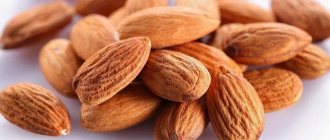April 23, 2015 Varieties and recipes
Oriental coffee is one of the oldest and most accessible methods of making coffee. This drink is prepared in a cezve, over an open small fire or on hot sand. Very often, spices are added to this oriental coffee to taste.
This is one of the most common and accessible coffee recipes today. In various sources, this drink is called differently: Turkish, Arabic, oriental coffee. Thanks to cooking in an open container, you can easily create the drink with as many additives as you like.
History of the origin of the drink
The Ethiopians were the first to prepare coffee beans. According to legend, even BC. The shepherd noticed that coffee beans had a stimulating effect on goats. He told about this in a monastery nearby. The monks tried the drink and felt the tonic effect, so they took it before evening prayers.
They experimented, roasted grains, and came up with cooking methods. At first, Ethiopians drank coffee only on special occasions, but gradually the frequency increased, and it became the hallmark of the country.
Over time, the drink was brought to Yemen by nomadic tribes and traders. The Arabs brewed coffee from the pulp of unroasted beans, so it turned out light. A method of preparation close to ours, oriental coffee was invented in the Middle East in the 12th century. Under the reign of Peter I, the drink firmly entered the culture of the nobility of that time and gradually spread to the common people of Russia.
How to brew coffee in Turkish
Millions of people start their day with a cup of aromatic and invigorating coffee. There are several ways to brew coffee: over a fire, in a coffee machine and, less commonly, on sand. If your favorite drink is brewed in a Turk, then this article is especially for you! Now you will learn exactly how to properly brew coffee in a Turk, Turkish coffee recipes and many useful subtleties.
We will need your favorite type of coffee, cold water, a coffee spoon (you can recognize it by its long handle) and, of course, a Turk.
By the way, what kind of object is this - a Turk? Turka, also known as cezve, is a special vessel for making coffee in the Oriental or Turkish style. As experts note, coffee brewed in a Turk has a richer taste and thicker consistency. All substances contained in roasted coffee beans remain practically unchanged in the cezve. Turka is one of the most ancient devices for making coffee.
A real Turk has a conical shape, a flat bottom and a narrow neck. Moreover, the greater the difference between the diameter of the bottom and neck, the better. It’s great if the Turk is made of copper - since ancient times this material has been considered the most suitable for a high-quality cezve.
Turkish coffee recipe 1. Grinding the beans. This stage is very important, since half the battle depends on its success. The process also involves preliminary selection of grains. After all, we all know very well that good coffee can only be obtained from high-quality coffee beans. The grains themselves should be ground as finely as possible - then the process will be more successful. 2. It is necessary to heat the Turk. To do this, place the vessel on low heat. If you have a copper pot, then you are a winner, since this material heats up more evenly. There is no need to heat the container - just warm the bottom a little. 3. Pour the ground grains into the Turk. Here everything is decided by your personal preferences - some people like stronger coffee, others - softer. However, you should know that the classic coffee ratio is two teaspoons per 150 grams of water. Remember, the main thing is not to skimp on coffee! If you like coffee with sugar, it is better to add it to the drink at this stage. Various seasonings such as ginger, cinnamon or vanilla are also poured along with the coffee itself. Instead of various herbs, some lovers add a pinch of salt, believing that it helps to highlight the notes of natural strong coffee, but this is a matter of taste. 4. Pour cold water into the Turk. It is in this sequence that the process of brewing coffee in a Turk takes place, and not vice versa. We pour water to the narrowest place in the cezve, so that there is still free space left to the edge. 5. Now the most interesting part: the process of brewing the drink. Many people are interested in how to properly brew coffee in a Turk, so it is necessary to point out some important points. First, while the coffee is heating, pour boiling water into the cups. This is done in order to heat them up. Hot coffee is not poured into cold containers - it is believed that the drink will suffer from this (boiling water is poured into cups for a short time and immediately poured out). The Turkish coffee should be stirred at this time. Gradually a creamy foam appears on its surface. It should be removed with a spoon, preferably a silver one, and transferred to cups. Please note that if you are preparing coffee for yourself and guests, then first of all you should put foam in the guests’ cups as a sign of attention - this is part of the so-called coffee etiquette. The foam should be removed several times during the brewing process of coffee in a Turk. Please note that coffee should never be boiled! Therefore, as soon as the so-called cap appears in the cezve, immediately remove the coffee from the heat, otherwise the taste of your favorite drink will be greatly affected. Don't let the coffee boil! Experts advise that after you remove the foam, hold the coffee over the fire for another ten seconds, and the drink is considered ready. Many coffee lovers consider a good mood to be another important detail. Skeptics may grin, but anticipating the pleasure of a superbly prepared drink and enjoying it will not be amiss.
6. Ready coffee. This stage is something like checking the readiness of the coffee. Here you should pay attention to how the foam in the cup covered the drink. It should be uniform, light in color and without any holes! Ideally, the foam on the coffee should resemble an airy cream.
Making coffee on sand in a Turk Initially, the cezve was used to make good coffee on sand. The drink prepared in this way was called oriental coffee, and then this became the name for all coffee brewed in a Turk.
How to make oriental coffee or sand coffee? The bottom of the cezve is immersed in hot sand (since this method came to us from the Bedouins of the East, the question of where the hot sand was taken disappears by itself).
Coffee, sugar and spices to taste are first poured into the container. All this is filled with cold water.
As soon as the Turk is immersed in the sand, the water in it instantly heats up. This happens due to the fact that the sand adheres to the entire surface of the bottom of the cezve and evenly transfers heat to it.
Since making coffee on sand in our city apartments is a very difficult process, exotic lovers have found a way out by creating a special machine. With its help, you can make coffee on sand in a Turk at any time without leaving your kitchen.
It is not for nothing that Turkish coffee is considered one of the most popular methods of preparing coffee, which demonstrates a rich, rich taste and unique aroma. Good coffee brewed in a cezve retains most of its beneficial substances, so enjoying such a drink is not only pleasant, but also healthy.
The most popular products in the category – Coffee beans
Turkish coffee recipe 1. Grinding the beans. This stage is very important, since half the battle depends on its success. The process also involves preliminary selection of grains. After all, we all know very well that good coffee can only be obtained from high-quality coffee beans. The grains themselves should be ground as finely as possible - then the process will be more successful. 2. It is necessary to heat the Turk. To do this, place the vessel on low heat. If you have a copper pot, then you are a winner, since this material heats up more evenly. There is no need to heat the container - just warm the bottom a little. 3. Pour the ground grains into the Turk. Here everything is decided by your personal preferences - some people like stronger coffee, others - softer. However, you should know that the classic coffee ratio is two teaspoons per 150 grams of water. Remember, the main thing is not to skimp on coffee! If you like coffee with sugar, it is better to add it to the drink at this stage. Various seasonings such as ginger, cinnamon or vanilla are also poured along with the coffee itself. Instead of various herbs, some lovers add a pinch of salt, believing that it helps to highlight the notes of natural strong coffee, but this is a matter of taste. 4. Pour cold water into the Turk. It is in this sequence that the process of brewing coffee in a Turk takes place, and not vice versa. We pour water to the narrowest place in the cezve, so that there is still free space left to the edge. 5. Now the most interesting part: the process of brewing the drink. Many people are interested in how to properly brew coffee in a Turk, so it is necessary to point out some important points. First, while the coffee is heating, pour boiling water into the cups. This is done in order to heat them up. Hot coffee is not poured into cold containers - it is believed that the drink will suffer from this (boiling water is poured into cups for a short time and immediately poured out). The Turkish coffee should be stirred at this time. Gradually a creamy foam appears on its surface. It should be removed with a spoon, preferably a silver one, and transferred to cups. Please note that if you are preparing coffee for yourself and guests, then first of all you should put foam in the guests’ cups as a sign of attention - this is part of the so-called coffee etiquette. The foam should be removed several times during the brewing process of coffee in a Turk. Please note that coffee should never be boiled! Therefore, as soon as the so-called cap appears in the cezve, immediately remove the coffee from the heat, otherwise the taste of your favorite drink will be greatly affected. Don't let the coffee boil! Experts advise that after you remove the foam, hold the coffee over the fire for another ten seconds, and the drink is considered ready. Many coffee lovers consider a good mood to be another important detail. Skeptics may grin, but anticipating the pleasure of a superbly prepared drink and enjoying it will not be amiss.
What is oriental coffee?
Depending on the amount of sugar used during its preparation, this type of coffee can be bitter, sweet or very sweet. The quality of the grind and the amount of water and coffee create room for variation: the drink can be thinner or thicker.
Spices that are traditionally used to make oriental coffee: cinnamon, cardamom, cloves, nutmeg, black pepper, garlic, salt. They give the drink a unique “zest”.
Among the many options for preparing oriental coffee, Turks pour a little granulated sugar into the bottom and put it on the fire. After the sugar turns brown, it is poured with water. At the same time, you need to make sure that the sugar does not burn, otherwise the coffee will have a bitter aftertaste.
Coffee grinding requirements
To make the drink truly tasty, aromatic and correct, it is very important to follow the rules for choosing the main ingredient:
- the quality of the beans must be the highest - you can choose both high-quality Arabica beans and blends of flavors;
- The grinding of the beans should be fine - this results in a thick, aromatic and tasty drink;
- It is better to grind the grains in a special machine, since ordinary coffee grinders do not give the desired result - the fractions are not very fine;
- It is better to take purified, soft water without any metal impurities.
In the case of a Turkish coffee recipe, grinding also plays an important role - it should be the finest, in other words, the grains should be crushed into dust. And if you follow the preparation rules, you will get aromatic, original and amazingly tasty coffee.
Features of the Arabic drink
Coffee is prepared by hand, just like centuries ago. A real oriental drink cannot be prepared in a coffee machine. The fact is that the traditional recipe uses very fine grinding. It's essentially coffee dust.
Bitterness and rich taste are the hallmark of oriental coffee. Arabs always add spices to their coffee, such as cardamom. This makes the drink aromatic and spicy. Ideally, different types of grains are used. When fried, they have a light yellow color, which is achieved due to exposure to water vapor. A blend of Arabica and Robusta directly affects the richness.
Classic cooking method
For the recipe you will need a copper cezve or simply a Turk. The walls of this cookware must be thick and preferably silver-plated on the inside. Turks come in different sizes, but it is better to take those that are designed for one serving.
In the East, they use an iron pan, onto which fine sand is poured and placed on the fire. The sand must be stirred so that it warms up evenly, after which the cooking process can begin.
It is difficult to imagine such a ritual at home, so it is important to purchase at least the right Turk. Not long ago, special coffee makers with heating elements and a reservoir filled with sand were put on sale. It allows you to bring the taste of the drink as close as possible to the traditional one.
How to brew Turkish coffee correctly
For true admirers, they also sell a special set for making oriental coffee at home.
Ingredients:
- 10 g ground beans;
- 120 ml water;
- sugar and spices to taste.
To begin with, the required amount of ground grains and sugar, as well as spices, are placed in the Turk. This mixture is heated slightly and poured with cold water, after which the ingredients are mixed. The Turk should be constantly rotated until the foam cap rises. It is important that the coffee does not heat above 95 degrees and does not boil. That’s why they use hot sand or, in extreme cases, low fire.
As soon as a thick head appears, the Turk is lifted so that the water does not splash out over the edge and then returned to the fire again. This is repeated several times until the foam brightens and becomes airy. This means the coffee is ready. First add a spoonful of foam into heated cups and then pour the drink.
In the East, coffee is served directly in the cezve - this is considered a sign of respect and hospitality
Drinking culture
According to Eastern traditions, coffee is served according to seniority, from oldest to youngest. The host serves his guests at least 3 cups of drink. Asking for another cup is considered bad manners. You just need to accept gifts from the owner.
Only cups made of ceramics and porcelain are suitable for serving. Arabs believe that the taste of coffee will deteriorate if served in paper or plastic containers.
Drink coffee in small sips, washing down each sip of coffee with cold water, preferably with ice.
Rules for serving and consumption
Coffee is served in small cups, the grounds are not drained. To speed up the sediment, you can add a couple of drops of cold water to the cup. You should drink oriental coffee in small sips, washing it down with cold water, which makes it possible to fully appreciate the aroma and taste of the drink.
When serving, certain rules are followed: foam is poured into the cups first, after which the drink itself is poured. Sugar, spices and spoons are not served as all the necessary ingredients are added during cooking. The cups themselves can be thick-walled ceramic or special thin-walled glass, which maintain the temperature of the drink for a long time.
To serve, you can use special sets that include a Turk, a cup and a saucer, made in the same style. They are placed on a small tray, with a glass of water placed on the left. When serving, you can carefully collect the coffee foam with a spoon, pour the drink into cups, and then carefully place the collected foam on top.
Spices in oriental coffee
In Europe, coffee is also drunk with spices. Just look at the popularity of cinnamon. But if you take cardamom, its percentage in a cup is 10%. Eastern residents add much more cardamom, noting its beneficial properties for the body. For example, the spice cleanses the blood, improves the functioning of the heart and blood vessels, and also tones the body well.
Cardamom goes well with cinnamon, so you can safely put ground cinnamon in oriental coffee, or in the form of a stick. Cinnamon is also very beneficial for health. It can even lower your blood sugar levels. The spice is added to ready-made coffee.
Cloves and star anise will also not spoil the taste of oriental coffee. However, in this case, you should not combine them with cardamom; you need to replace it. A few grains of star anise allow you to feel the spicy taste.
Star anise is mixed with coffee in Turk. To reveal the full aroma, the finished drink can be covered with a lid for a few minutes, and only then start drinking.
Secrets of oriental coffee
The process of making oriental coffee requires regularity, adherence to the sequence of steps and high-quality ingredients. There are several main secrets that will allow you to achieve the strength and harmonious taste of the drink:
- Coffee beans must be Arabica beans of any roast level. Grind them immediately before the cooking process so that the esters do not have time to evaporate. The grind should be very fine powder so that the grounds do not squeak on your teeth. You can also purchase a ready-made mixture for oriental coffee, for example, the Jockey brand.
- The water should be soft, preferably spring water, which is free of impurities and odor. As a last resort, use filtered or softened store-bought water. An important rule: coffee is poured with cold water so that the beans can better release their aromatic properties.
- Eastern baristas do not get rid of the foam, but add it to the bottom of the cup and then pour the finished drink. They believe that it is in the foam that the flavor pyramid and richness of aroma lie.
- Sugar (preferably brown) and oriental spices must be added to the drink.
Different countries have their own recipe for oriental coffee, but traditionally it should contain cardamom and a few more spices
The most popular among them are:
- ground black pepper,
- ginger,
- cinnamon,
- cocoa.
There are also recipes with the addition of liqueur, cognac, cream, and lemon.
What's the secret
Oriental coffee, like any dish of national cuisine, has its own cooking secrets. It turns out truly tasty and aromatic only if all preparation technologies are followed. Let's start with the Turka or cezve, as it is often called. Without this metal utensils, coffee will not work; it will be a completely different drink. Cezva, translated from Turkish, means a vessel for brewing coffee and is a thick-walled ladle with a handle, most often made of forged copper. The name changes in different languages. It is this device that helps prepare divinely tasty and aromatic oriental coffee. True gourmets and coffee connoisseurs believe that only coffee brewed in this small ladle can rightfully be considered the height of perfection. Those who have at least once in their life tasted real Turkish coffee, brewed according to all the rules, will understand why it is one of the ten best drinks in the whole world. People in all countries love and prefer it.
It is worth noting that oriental coffee is not a separate variety or variety of coffee beans, it is an original way of preparing an invigorating drink. All types of beans and any degree of roasting are suitable for making this coffee; the most important condition is their freshness. The coffee grind should be as fine as possible; it is also called “dust” or “flour”. It is the presence of a fine suspension of ground coffee that gives this drink its zest. Water itself plays a very important role; this component is chosen especially carefully. Only spring or filtered water is suitable, which should be soft and lively. This gives the drink a refined aristocratic taste. Boiled water or, worse, tap water can ruin the whole taste.
Coffee came from the East
The version that coffee came from the East is confirmed by both botanists and historians. And although the birthplace of the coffee tree is Ethiopia, a country located in eastern Africa, Yemen should be considered the birthplace of the coffee drink. It was from here that the victorious march of coffee around the world began. From this Arab country, coffee came to Egypt, Turkey and Syria. Already in those days (14-15 centuries), the technology for preparing coffee drinks was practically no different from modern ones.
Coffee has a sacred meaning in the Islamic world. For a long time it was a substitute for wine, which is forbidden to the faithful. Coffee was used in religious ceremonies. The destruction of coffee trees was severely punished, including the death penalty. The reverent attitude towards the drink can be traced in today's coffee ceremonies in the countries of the East.
For example, Turkey still uses its own method of roasting grains. Beginning in the 14th century, roasted grains were ground together with spices and the addition of water. The coffee mixture was then roasted again. The resulting powder became known as Turkish coffee. This is the recipe for roasting Turkish coffee today.
In the homeland of coffee, in Yemen, the coffee drink was prepared from crushed, roasted coffee beans along with the shell. The coffee mixture was then brought to a boil twice, after which ginger root was added. The thick drink was poured into three sips: “The first is bitter like life, the second is sweet like love, the third is unknowable like death.”
Arabic coffee
This drink should be drunk in warm company and savored. He does not tolerate fuss, not during cooking, not during meals. Has a slightly bitter taste. The Egyptians equate it with a divine drink.
Components:
- ground coffee bean powder - 10 g;
- sugar - 10 g;
- water - 125 ml;
- cardamom - 0.7 g;
- vanillin - 0.7 g
Preparation:
- Pour all the ingredients into a cezve (a vessel with a long wooden handle). Fill the entire mass with water.
- Put it on slow gas. Wait until the foam appears. Remove from the oven and let stand for a while.
- Repeat the process two more times. The slower the drink is brewed, the better.
- Now all that remains is to skim off the foam into the cups with a spoon, and then pour the drink with the grounds and slowly enjoy the wonderful taste of aromatic coffee.
To prepare this divine drink, special Arabic coffee beans with the addition of cardamom are used. They should not be confused with Arabica coffee. Otherwise you will end up with a completely different drink.
Cardamom is an aphrodisiac. Among other things, this spice cleanses blood vessels, stimulates the normal functioning of the heart muscle, relieves excessive irritability, and gives energy.
When preparing the drink at home, you can make changes to the recipe. Add your favorite spices and make the coffee not so bitter or spicy. After all, no people have the same tastes and preferences. Therefore, recipes can and should be changed. Thanks to this, new ways of preparing incredibly tasty drinks from coffee beans are emerging.
Spices for an oriental recipe
There are no spices that are not suitable for Turkish (or oriental) coffee. Traditionally, cinnamon and vanilla were used, as well as cardamom in Arab countries.
But there are other varieties that can be added:
- ginger;
- nigella (Kalinji);
- carnation;
- star anise;
- black pepper or chili;
- coriander;
- saffron.
And others. There is no ban on coffee experiments. There is even a recipe with pink Indian salt. Why they drank coffee with salt in the East can be theoretically understood. Heat, lack of water, and coffee has a pronounced diuretic effect.
Salt helped retain water in the body. An analogue of salted coffee is salted Uzbek tea. Unlike simple salt, Indian salt contains almost the entire periodic table, therefore it is several times more useful. It is collected by hand near volcanoes.
Coffee on sand in a coffee shop: what to cook with
To prepare an oriental drink in a coffee shop you will need special equipment. We are talking about a heating platform into which fine-grained quartz sand is poured.
Such a device is connected to the power supply, after which it slowly warms up. As soon as the sand on the platform reaches a certain temperature, a cezve with coffee is placed in it.
The device in the form of a kind of brazier is not cheap, so you need to be especially careful when choosing it. And here you need to know a few subtleties:
- Equipment from good manufacturers is usually equipped with a Turk and sand. True, such a coffee set will cost a pretty penny. If the platform is sold without such components, you will have to select them yourself.
- Most coffee gourmets know that the best cezve is made of copper. Therefore, if you are choosing a Turk yourself, it is better to give preference to this particular metal.
- The dimensions of the fryer depend on the number of servings of the drink that need to be prepared at the same time. Coffee according to this recipe is drunk immediately after preparation, so it is advisable to take the volume of the Turkish coffee for one serving.
- The sand must be fine-grained, quartz. You can, of course, experiment with sea and river sand. But they do not hold heat as well as quartz.











